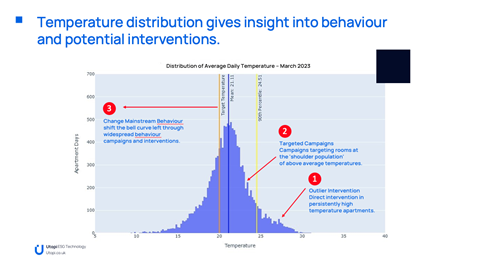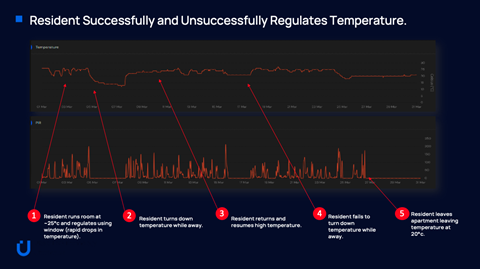It’s no surprise to anyone in the real estate sector that net zero carbon is approaching, and fast.
But without a baseline of understanding when it comes to current emissions, and current behaviours, how can anyone expect to make or measure positive impacts? This is where data comes in.
The Utopi difference: The data
Utopi currently holds over 3.1 billion environmental data points across 150+ assets and 19,000+ beds, with over 30,000+ devices collecting hourly data on:
- Temperature
- Air quality
- Noise and light
- Motion
- People counting
- Energy consumption
- And more
But while data is where the power for change begins, we know achieving real results comes down to a combination of asset level controls and changing the behaviours of residents and site operations teams. Utopi is therefore investing in the capabilities needed to generate a deep, data driven understanding of behavioural change, and ensure we lead the market to sustainable living.
Our Changing Behaviours Programme: Based on data NOT anecdote
Following our pioneering Changing Behaviours Report, published in 2022 with partners ASK4 and Spike Global, Utopi has initiated its own Changing Behaviours programme to understand resident behaviour and drive change in ESG performance. Our aim is to identify patterns of resident behaviour from our data and use this to target behavioural change; and in doing so, help clients reduce carbon emissions through the reduction in temperature, and a reduction in associated utility costs.
Since launching the programme in July, we’ve established a baseline of resident behaviours based on data from 1000+ apartments across six BTR and PBSA assets. As an example of the type of insights that we can achieve, we have learnt that, for this sample of assets:
- 10% of residents consistently run temperatures >24°C
- 50% of residents take at least one >2 day break per month
- >75-95% fail to turn down their heating while they’re away
- 60% of apartments unoccupied over Christmas are left at over 20°C
- 90% of overheated rooms use windows to regulate the temperature
Breaking down the baseline data:
1. Understanding temperature distribution

Temperature is a useful proxy for energy consumption. Plotting the distribution of temperatures across all apartments in an asset in any one month shows a natural spread in temperatures, which is substantially due to resident behaviour.
This analysis identifies three target resident populations: a small number of outliers in the highest temperatures (25°C or higher), a group of above average residents (21-25°C) and the mainstream building population (15-25°C). Each group is a potential target for specifically-designed interventions designed to reduce excessive energy consumption, moving these groups to lower temperatures.
2. Deeper dive into resident behaviours

The Utopi platform enables us to dive deeper, looking more closely to understand resident behaviour in one apartment. Combining temperature (above) and occupancy (below) in the figure above, we see a resident running the room at elevated temperature (1), leaving the room and turning the heating off (2), returning and resuming the high temperature heating (3), leaving the room and leaving the heating on (4), and then then finally seeing the resident move out and the room remaining at 20°C when unoccupied. At this granular level of data, it becomes clear where interventions can make a difference; and how best to target interventions to encourage more sustainable living.
Designing interventions for behavioural change
Based on this learning, we are now designing interventions to address these behavioural patterns using the B-COM model of behaviour change – understanding the Capability, Opportunity and Motivation of residents to change Behaviour.
We are operating live pilots where we are trialling interventions including:
1. Engaging Outliers: Automated reports are sent to operating teams by email daily, weekly or monthly via the Utopi Platform, identifying rooms with consistently high temperatures and enabling guided conversations to support resident behaviour change.
2. Targeted Campaigns: Identifying segments of residents who have a common set of behaviours. Targeting those people with specific campaigns.
3. Whole Building Campaigns: Multi-channel campaigns to raise awareness of behaviour change, eg: turn down the heating when you leave. These could be supported by the Utopi resident app, to gamify that change.
The journey from here
Utopi is very much at the beginning of our journey into understanding resident behaviour and how we can effect behaviour change to enhance sustainability. The number of assets connected to the Utopi platform is growing exponentially, and with it the increasing opportunity to change behaviour at scale.
If you want to join the pilot programme, please get in touch with Utopi and follow us on social media for more.





























No comments yet